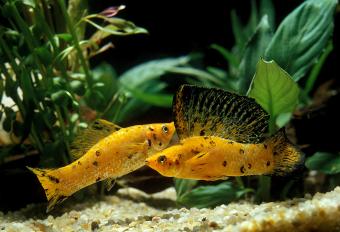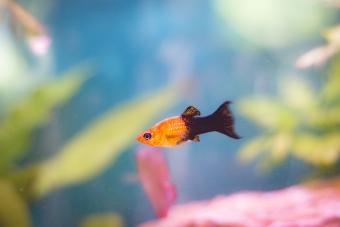
The snowflake eel (family Muraenidae) is one of 11 species of moray eel in the genus Echidna, commonly found in shallow tropical and subtropical oceans. The snowflake eel is one of the most beautiful eels you can add to your saltwater aquarium. They're also one of the most adaptable as they don't get as large as other moray eels and their temperament is not as aggressive.
Snowflake Eel Overview
The snowflake eel, or E. nebulosa, is a moray eel known by a few other names, including:
- Bosch's reef eel
- Clouded moray eel
- Floral moray eel
- Nebulous moray eel
- Starry eel
- White and zebra moray
They are native to parts of the Pacific Ocean and can be found living in reefs in the Indo-Pacific and along the western coast of the United States, Mexico, and Central America, as well as by Hawaii. They typically grow to about 2 to 3 feet in length, though they can get close to 4 feet long. The snowflake eel is recognizable for their colorful pattern which is composed of a silvery-white body with broken speckled bands of dark brown to black and yellow spotting. Their head from the eyes to the tip of the snout has no markings. The dark eyes have a yellow ring around them.
Snowflake Eel Temperament
Like many of the moray eels, the snowflake eel can become aggressive at feeding time. However it can also be one of the more placid eels compared to other morays. Some owners have even trained them to be hand-fed, though this should be done with extreme care and caution.
The snowflake eel has poor vision and very strong teeth which can inflict a nasty, painful bite. Teaching the eel to associate your hands with food can have unfortunate consequences. The snowflake eel likes to spend much of its time hiding under rocks and in crevices with only the head showing. In fact it will do this most of the time when first introduced to a tank until it feels comfortable exploring more. They tend to be more active in the tank at night as they instinctively hunt for food in the evening.
The Escape Artist Snowflake Eel
One behavioral quirk of the snowflake eel that you should know from the start is their propensity for escaping their tank. They have been known to squeeze their way into any opening they can find that they can fit through. This means making sure any filter or plumbing openings in the tank are fitted with a sponge or sleeve to block entry.
They can also jump somewhat out of the water, and if your tank is not covered, they can manage to get out this way. You should ensure your tank lid can be locked down or secured, as they are strong enough to press against it and move it.
Snowflake Eel Care
The snowflake eel is known for adapting well to an aquarium setup. Providing that you have its basic needs met, your snowflake eel should thrive.

Snowflake Eel Tank Requirements
A snowflake eel would do best in a saltwater tank that is at least 75 gallons. Some hobbyists will keep them in smaller tanks of 50 gallons and up, but it's best to provide a larger tank as they can grow bigger, and the more you feed them the faster they will size up. They will need a setup that approximates living in a real-life reef environment. This means lots of live rocks set up with places for them to hide.
However, keep in mind that the eel moving around in these crevices and caves can cause rocks to move. These eels are strong, so you need to make sure your setup is stable and the rock structure is impervious to the eel pressing against it or under it. Some snowflake eel keepers use cut-up sections of large PVC pipes underneath live rocks in their tanks as hiding places. They also enjoy hiding in sand, so providing an area of about 2 to 3 inches in thickness in the tank would be appreciated by your snowflake eel.
Snowflake Eel Water Care
The snowflake eel needs a saltwater environment with a temperature between 72 and 78 degrees Fahrenheit. Maintain pH between 8.1 to 8.4, salinity/specific gravity at 1.020 and 1.026, and alkalinity around 8 to 12 degrees of carbonate hardness (dKH). You should also have a strong filter and a protein skimmer to keep the water clean and you will need to be ready to do frequent water changes. Snowflake eels are definitely messy and keeping on top of their water quality is vital for their good health.
Diet of the Snowflake Eel
Snowflake eels have a carnivorous diet and they need to be fed about two to three times a week. They can eat pieces of fresh or frozen clams, crab, fish, mussels, octopus, scallops, shrimp and squid. They also can eat dried or frozen krill. Never feed them feeder fish like goldfish, rosy reds or other freshwater fish, as this can make them very ill.
These eels are known to bite owners' hands when food is on offer, so avoid hand feeding them. The best way to feed snowflake eels is by placing the food near them with a set of long tongs, or sticking the food on a feeding stick. It's best to keep your hands out of the aquarium, well away from their mouths and the food, to avoid being bitten.
Lifespan and Health of the Snowflake Eel
The average lifespan of the snowflake eel is about 4 years. They are generally healthy with few known medical conditions. You should occasionally add vitamins to their meals -- especially if you are feeding frozen, non-prepared foods -- to help keep their immune system in good shape. Remember to avoid feeding them any type of freshwater fish. Make sure they are also not over fed, which can lead to physical problems. They are vulnerable to common saltwater fish diseases brought on by poor tank management, such as oxygen starvation, nitrate poisoning, and ammonia poisoning.
Best Tank Mates for a Snowflake Eel
Despite the fact that they are carnivorous hunters, the snowflake eel can share a tank with other fish. Although they are considered "fish safe," you should avoid keeping any type of fish that is small enough to fit in their mouths in the event they're hungry and don't want to wait for a feeding. Avoid keeping them with any crustaceans regardless of size, as snowflake eels will consider these a tasty meal opportunity.

Tank Mates to Consider
They do best with large fish with semi-aggressive to aggressive temperaments. Good tank mate choices include butterflies, large gobies, groupers, large damsels, lionfish, puffer fish, tangs, triggerfish, and wrasses. They also can live happily with other common reef invertebrates such as anemones, gorgonians, sea urchins, and starfish as well as corals, though they have been known to mess with corals unintentionally, possibly dislodging them, when moving around the tank.
Other Snowflake Eels
If your tank is large enough, you can also have more than one snowflake eel, but it's best if they're both about the same size and added to the tank at the same time. It's important to be aware that snowflake eels can become aggressive with each other, as well as to other tank mates, during feeding times. They also would not do well with most other species of moray eel, especially ones that are larger.
Learning About Snowflake Eel Care
The snowflake eel is a lovely addition to any reef tank, although they do have some specific are requirements that might make them more difficult for the novice fishkeeper. They're a great choice for a first-time saltwater eel, as they do not grow as large as others and other than feeding time are generally calm and less aggressive than others of their species. If you're thinking about getting a snowflake eel, take the time to make sure you have the right set up and understand all their water, diet, and tank setup requirements so you can provide your eel with a long-term happy life in your care.







